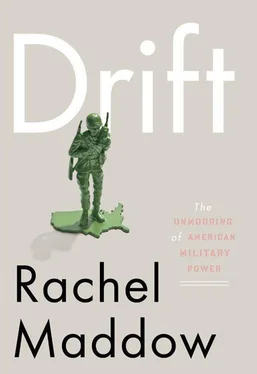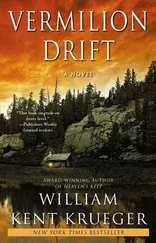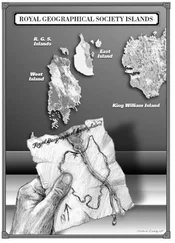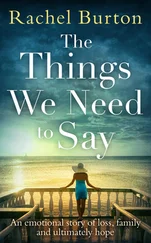If no one knows if it’s making us safer, why have we built it? Why are we still building it, at breakneck speed? Liberty Crossing is slated to almost double in size over the next decade. Remember the fierce debate in Congress over whether or not it’s worth it to do that? No? Me neither. But we keep building it. We keep chugging along.
National security is a real imperative for our country—for any country. But the connection between that imperative and what we do about it has gone as frowsy as my hometown’s little pump station in high August. Our national security policy isn’t much related to its stated justifications anymore. To whatever extent we do argue and debate what defense and intelligence policy ought to be, that debate—our political process—doesn’t actually determine what we do. We’re not directing that policy anymore; it just follows its own course. Which means we’ve effectively lost control of a big part of who we are as a country. And we’ve broken faith with some of the best advice the founders ever gave us.
Our constitutional inheritance didn’t point us in this direction. If the colonists hadn’t rejected British militarism and the massive financial burden of maintaining the British military, America wouldn’t exist. The Constitutional Convention debated whether America should even have a standing army. The founders feared that maintaining one would drain our resources in the same way that maintaining the eighteenth-century British military had burdened the colonies. They worried that a powerful military could rival civilian government for power in our new country, and of course they worried that having a standing army around would create too much of a temptation to use it. Those worries about the inevitable incentives to war were part of what led to the division of government at the heart of our Constitution, building into the structure of our new country a deliberate peaceable bias.
But in the past generation or two, we’ve drifted off that historical course. The steering’s gone wobbly, the brakes have failed. It’s not a conspiracy, there aren’t rogue elements pushing us to subvert our national interests to instead serve theirs. It’s been more entertaining and more boneheaded than that.
The good news is we don’t need a radical new vision of post–Cold War American power. We just need a “small c ” conservative return to our constitutional roots, a course correction. This book is about how and why we’ve drifted. It wasn’t inevitable. And it’s fixable.
CHAPTER 1
G.I. Joe, Ho Chi Minh, and the American Art of Fighting About Fighting
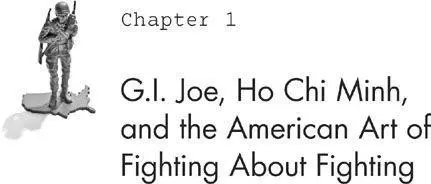
THOMAS JEFFERSON WAS A LIFELONG AND HABITUAL FRETTER. He was wary of animal foods, spirituous liquors, state religion, national debt, abolitionists, embittered slaves, unelected federal judges, Yankee politicians, Yankee professors, and Yankees in general. But his predominant and animating worry was the centralization and consolidation of power—in large banks, in closed and secret societies, and, most of all, in governments: the enemy within. “There are instruments so dangerous to the rights of the nation and which place them so totally at the mercy of their governors, that those governors, whether legislative or executive, should be restrained from keeping such instruments on foot, but in well-defined cases,” Jefferson wrote as the Constitution of the United States was being debated. “Such an instrument is a standing army.”
His feelings didn’t much change with time. In 1792 he wrote, “One of my favorite ideas is, never to keep an unnecessary soldier.” In 1799 he wrote to a political friend that he was “not for a standing army in a time of peace, which may overwhelm public sentiment.”
Classicist that he was, Jefferson was apt to bolster his arguments with well-polished (if not strictly accurate) examples of early Western history: “The Greeks and Romans had no standing armies, yet they defended themselves…. Their system was to make every man a soldier and oblige him to repair to the standard of his country whenever that was reared. This made them invincible; and the same remedy will make us so.”
That’s at best a loose military history of Greece and Rome—they did rely at times on standing armies. But you see where he’s going with this. Jefferson acted on his pet “unnecessary soldier” idea when he became president in 1801. He cut the standing army by a third and left the defense against foreign invasion largely to a “well-regulated militia” under the control of the various states and localities. And he remained unmoved by what he viewed as alarmist and cynical calls for a large nationalized active military. “Were armies to be raised whenever a speck of war is visible in our horizon,” he warned Congress in his sixth annual presidential message, “we never should have been without them. Our resources would have been exhausted on dangers which never happened, instead of being reserved for what is really to take place.”
Jeffersonian prudence held sway in this country for a century and a half. The professional military was an institution of limited reach and power; in times of peace we kept the regulars busy building defense works and ports and bridges. Whenever we went to war in a big way, we went to war with citizen-soldiers; the small nucleus of an active-duty army swelled with militiamen, reservists, National Guardsmen, enlisted persons, and draftees. When the United States went to war, the entire United States went to war. And no nation’s military demobilized with such verve and velocity when the fighting was over. Hell, volunteers on the battlefields were legally separating themselves from the US Army while the Mexican War still raged in 1847. The War of 1812, the Creek War, the Civil War, the Spanish-American War, they were all the same: the clarion call to duty, the citizens’ eager answer, the victory parades (having picked our fights judiciously, we were, by the mid-twentieth century, something like 9–0), and the return to home and hearth. Within eighteen months of the conclusion of World War I, Congress had completely dismantled the American Expeditionary Forces and reduced the active-duty military from four million soldiers back to the prewar number of less than three hundred thousand. The effect of tossing more than three million suddenly unemployed men back into an ailing job market did not have an altogether sanguinary effect on the national economy, or on the national mood… but hey, nobody ever said war was supposed to be a jobs program.
Mobilization for World War II was even larger, and the postwar drawdown nearly as dramatic. In 1945 there were twelve million people on active duty in the US Armed Forces; five years later, that number had dropped 88 percent, to just one and a half million. But that stunning demobilization had few concomitant dislocations. Call it the War-and-Peace Dividend or the World’s Greatest Stimulus Package. A country that left a Great Depression at home to confront the Axis powers overseas converted the massive government spending of the war effort into an unprecedented civilian economic boom when that war was won. Factories that had been making jeeps and warplanes and submarine engines and ammunition were now turning out new Chevrolet Bel Airs, Allis-Chalmers tractors, Cessna 170 airplanes, and Frigidaire iceboxes. It didn’t hurt our standing in the world economy that about one in five able-bodied young men in Germany and the Soviet Union had been killed in the war, and at least one in ten of Japan’s. And it didn’t hurt that the industrial cities of Japan and Germany (and much of Western Europe, for that matter) were smoking holes; of the 10.5 million cars manufactured worldwide in 1950, the United States made more than 8 million of them, and sold ’em all over the world.
Читать дальше
